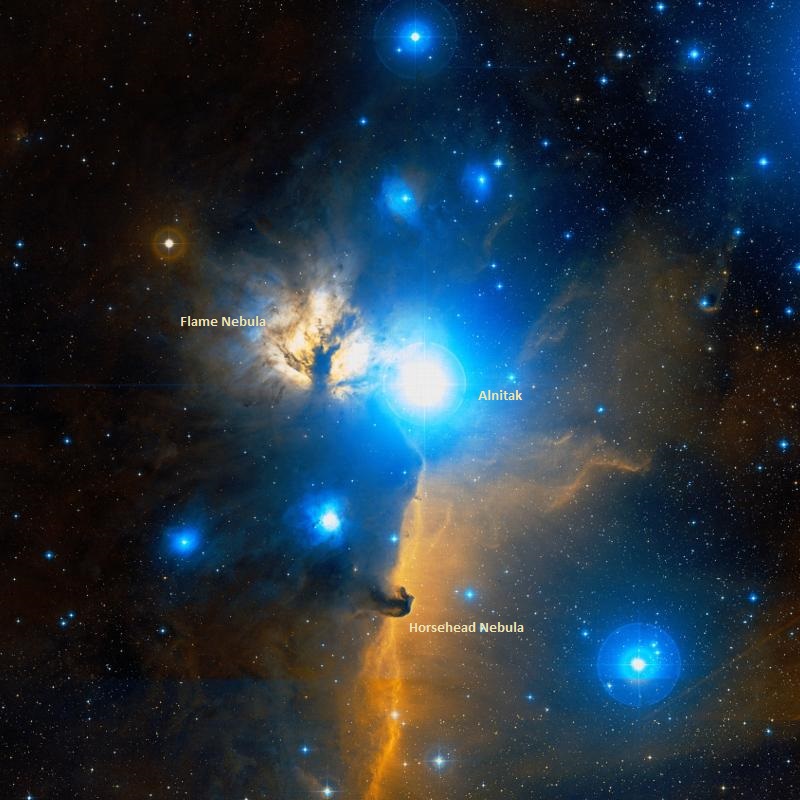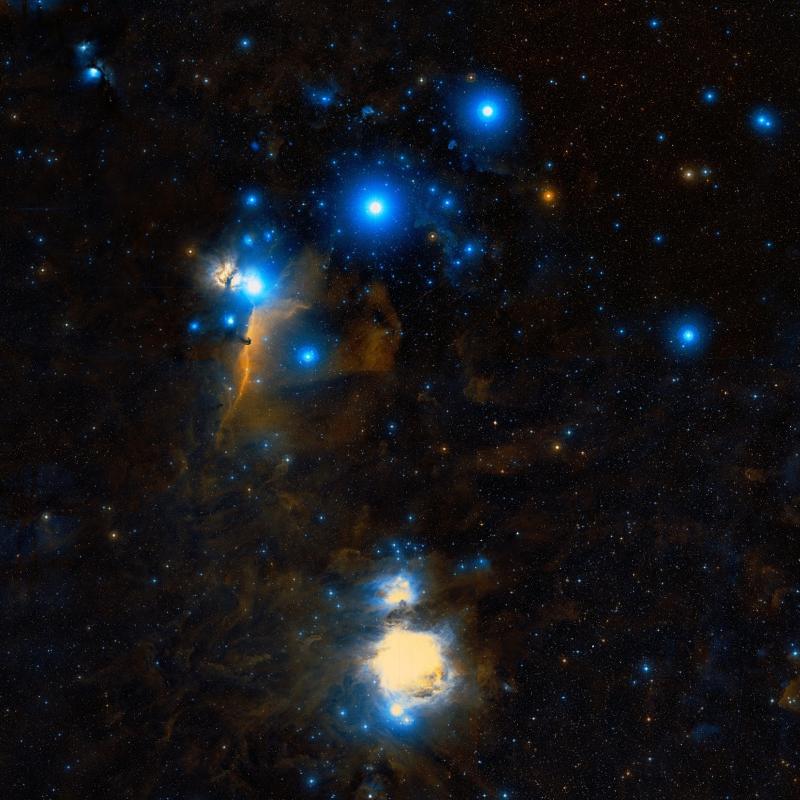Alnitak, Zeta Orionis (ζ Ori), is a triple star system with a combined apparent magnitude of 1.77. It lies at an approximate distance of 1,260 light years from Earth in the constellation Orion. Alnitak is the 5th brightest star in Orion and the 31st brightest star in the sky. It shares the 31s place with Alioth, the brightest star in Ursa Major. The two stars are only slightly fainter than Miaplacidus in Carina constellation, Alnilam in Orion and Alnair in Grus, and they just outshine Mirfak in Perseus, Dubhe in Ursa Major and Regor in Vela.
Alnitak is the easternmost star of Orion’s Belt, one of the best known asterisms in the night sky, also formed by the bright Alnilam and Mintaka.
Star system
Zeta Orionis is a multiple star system with at least three components. Alnitak A is a close binary star, consisting of components Alnitak Aa and Alnitak Ab. Alnitak Aa, the primary star in the Zeta Orionis system, is a hot blue supergiant with the stellar classification O9.5 Iab. It is the brightest class O star in the sky. The star has a visual magnitude of 2.0 and an absolute magnitude of -6.0. It has 33 times the Sun’s mass and a radius 20 times that of the Sun.
Alnitak Ab has the spectral classification of B1IV, indicating a blue subgiant star. It has an apparent magnitude of 4.28 and an absolute magnitude of -3.9. It lies only 11 astronomical units from the primary star, which makes the pair a very close binary system. To illustrate, the distance from the Sun to Saturn is about 9.58 astronomical units.
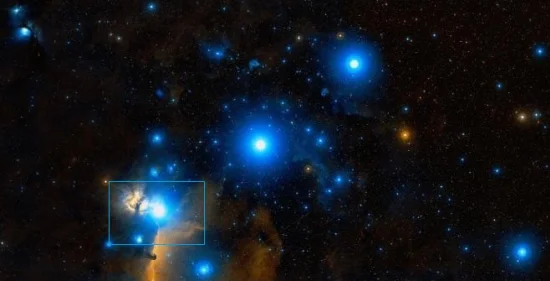
Alnitak and Orion’s Belt, image: Wikisky
Alnitak B is a class B giant star with a visual magnitude of 4.01. It orbits Alnitak A every 1,508.6 years. Unlike Alnitak Ab, which can only be detected spectroscopically and interferometrically, Alnitak B can be resolved.
The Zeta Orionis stars belong to the Orion OB1 association (subgroup OB1b) and are members of the Collinder 70 open cluster.
A fourth star, Alnitak C, can be seen in the vicinity of the system, but it is uncertain whether it is gravitationally bound to it or merely lies in the same line of sight.
Orion’s Belt
Alnitak forms the Belt of Orion, one of the most conspicuous asterisms in the sky, with its bright neighbours Alnilam and Mintaka.
The stars of Orion’s Belt have had many different names across different cultures. In Arabic, they are known as Al Nijād (the Belt), Al Alkāt (the Golden Nuts) and Al Mīzān al Ḥaqq (the Accurate Scale Beam). Their English folk names include Peter’s Staff, Jacob’s Rod (Staff), the Yard-stick, the Golden Yard-arm, the Three Kings (the Magi), the Three Marys and Our Lady’s Wand.
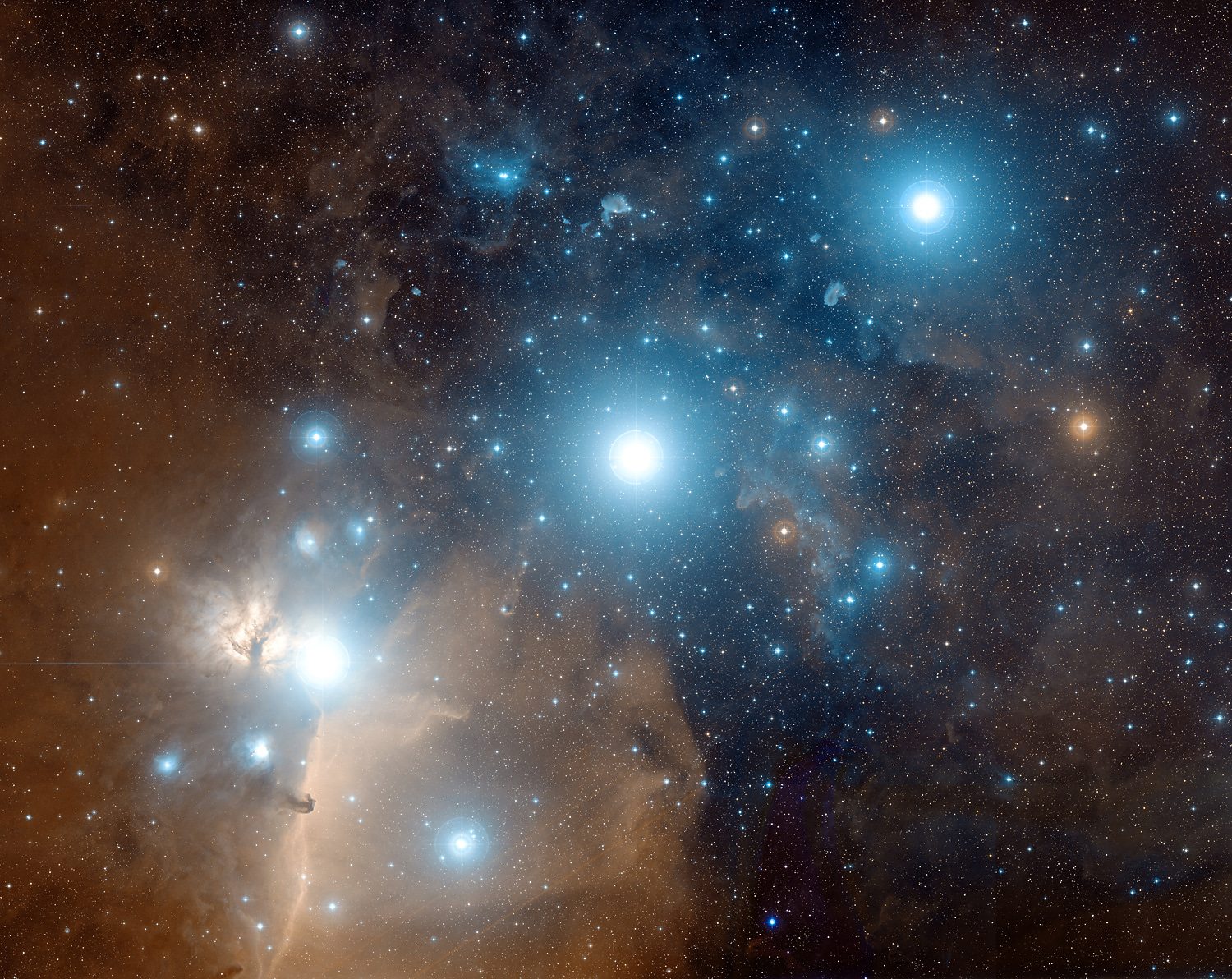
Orion’s Belt, image: Davide De Martin (http://www.skyfactory.org); Credit: Digitized Sky Survey, ESA/ESO/NASA FITS Liberator
In South America and Portugal, the three stars are known as “Las Tres Marías” (Spanish) and “As Três Marias” (Portuguese). In Puerto Rico and the Philippines, they are called “Los Tres Reyes Magos,” referring to the three Biblical Magi.
The Chinese know the Belt of Orion as the Weighing Beam. The three stars are part of as asterism known as Three Stars (參宿), formed by the Belt stars and other bright Orion stars: Betelgeuse, Rigel, Bellatrix and Saiph. Alnitak’s Chinese name is the First Star of Three Stars (參宿一), in reference to the asterism.
The stars of Orion’s Belt were part of ancient Egyptian culture as well. Orion and Sirius were associated with Osiris and his wife, and the gods were believed to have arrived from Orion’s Belt and Sirius to start the human race. According to the popular (but contested) Orion correlation theory, the pyramids at Giza were arranged to represent Orion’s Belt and the air shafts were built to project the pharaoh’s soul toward Orion.
Orion’s Belt is best seen in mid-December, when it is at its highest in the sky, and in January at 9 pm.
Facts
German amateur astronomer George K. Hunowsky reported Alnitak to be a double star in 1819. However, the blue supergiant was only recently found to have another companion. Scientists had suspected the presence of a close companion since the 1970s, when the star was observed with the Narrabri Stellar Intensity Interferometer, but the companion, Alnitak Ab, was not confirmed until 1998. It was discovered by a team from the Lowell Observatory in Flagstaff, Arizona.
Alnitak is surrounded by the bright emission nebula IC 434. Silhouetted against IC 434 is the famous dark Horsehead Nebula, which lies just south of Alnitak.
The nearby Flame Nebula (NGC 2024) is illuminated by the star’s strong ultraviolet light. The emission nebula is located just east of Alnitak.
In spite of being a relatively young star at 6.4 million years of age, Alnitak Aa has already stopped fusing hydrogen in its core. The star will eventually evolve into a red supergiant, one like Betelgeuse, before going out as a supernova.
Name
The name Alnitak (pronunciation: /ˈælnɪtæk/) comes from the Arabic an-niṭāq, which means “the girdle.” The name was officially approved for the star Zeta Orionis Aa by the International Astronomical Union’s (IAU) Working Group on Star Names (WGSN) on July 20, 2016. Even though the name formally applies only to Zeta Orionis Aa, it is commonly used for the whole system and its other individual components (Alnitak Ab, Alnitak B).
Location
Alnitak is easy to find because it is both bright and part of a recognizable asterism. It is the eastern star of Orion’s Belt, appearing to the left of Alnilam and Mintaka to northern observers.
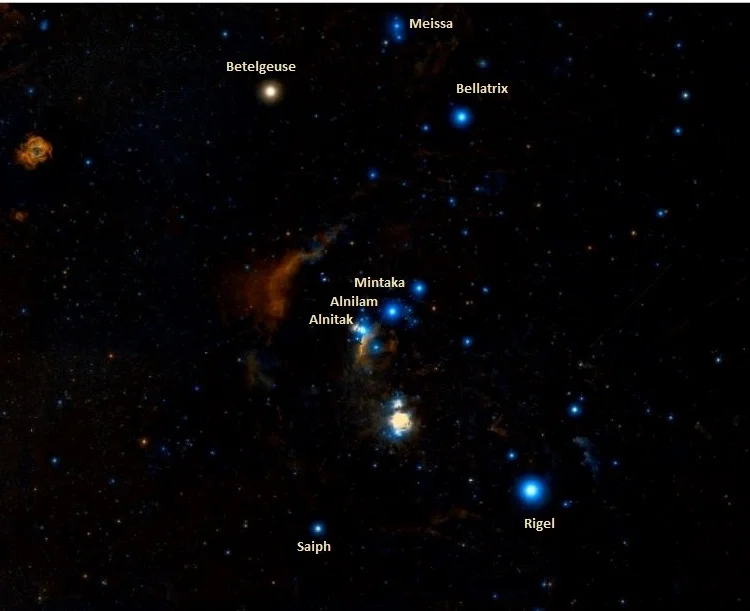
Orion stars, image: Wikisky
Orion’s Belt and the larger hourglass shape of Orion, outlined by the bright Betelgeuse, Bellatrix, Rigel and Saiph, can be seen from November to May in the early to late evening and from late July to November in the early morning hours. The constellation is particularly prominent in the sky during the northern hemisphere winter/southern summer. To southern observers, it appears upside down.
Constellation
Alnitak is located in the constellation Orion. Representing the celestial Hunter from Greek mythology, Orion is the 26th largest of the 88 constellations, occupying 594 degrees of the sky. Best known for the Belt of Orion and the first-magnitude stars Rigel and Betelgeuse, Orion is a popular target for stargazers. It is home to the nearest massive star forming region to Earth, the Orion Nebula (Messier 42), located just under Orion’s Belt, and a number of other interesting deep sky objects. These include the reflection nebula Messier 78, the dark Horsehead Nebula (Barnard 33), the H II region Messier 43, and the reflection nebula Sharpless 279 (Sh2-279), also known as the Running Man Nebula.
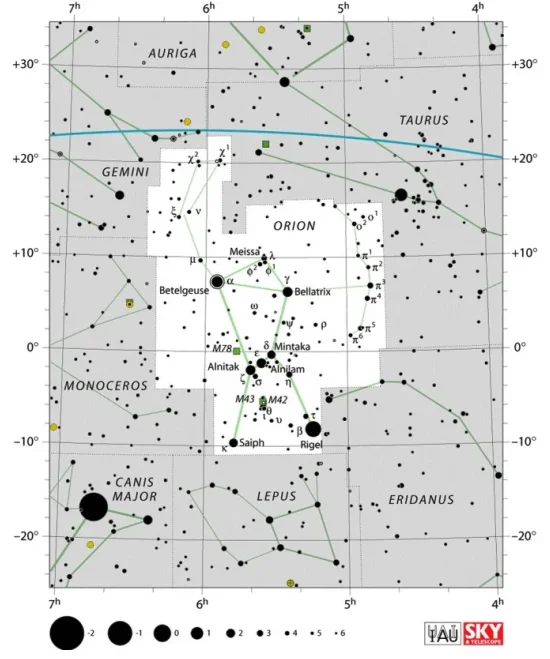
Orion constellation map by IAU and Sky&Telescope magazine
The 10 brightest stars in Orion are Rigel (Beta Ori, mag. 0.05 – 0.18), Betelgeuse (Alpha Ori, mag. 0.0 – 1.3), Bellatrix (Gamma Ori, mag. 1.59 to 1.64), Alnilam (Epsilon Ori, mag. 1.64 – 1.74), Alnitak A (Zeta Ori A, mag. 2.00), Saiph (Kappa Ori, mag. 2.09), Mintaka AB (Delta Ori AB, mag. 2.23), Hatysa (Iota Ori, mag. 2.77), Tabit (Pi3 Ori, mag. 3.16), and Eta Orionis (mag. 3.31 – 3.6).
Alnitak – Zeta Orionis
| Spectral class | O9.5Iab + B1IV + B0III |
| U-B colour index | -1.06 |
| B-V colour index | -0.11 (A), -0.20 (B) |
| Apparent magnitude | 1.77 (2.08 + 4.28 + 4.01) |
| Absolute magnitude | −6.0 / −3.9 / −4.1 |
| Distance | 1,260 ± 180 light years (387 ± 54 parsecs) |
| Parallax | 4.43 ± 0.64 mas |
| Radial velocity | 18.50 km/s |
| Proper motion | RA: 3.19 mas/yr |
| Dec.: 2.03 mas/yr | |
| Mass (Alnitak Aa, Ab) | 33 ± 10 M☉, 14 ± 3 M☉ |
| Luminosity (Alnitak Aa, Ab) | 250,000 L☉, 32,000 L☉ |
| Radius (Alnitak Aa, Ab) | 20 ± 3.2 R☉, 7.3 ± 1.0 R☉ |
| Temperature (Alnitak Aa, Ab) | 29,500 ± 1000 K, 29,000 K |
| Surface gravity (Alnitak Aa) | 3.2 ± 0.1 cgs |
| Age (Alnitak Aa, Ab, B) | 6.4 Myr, 7.2 Myr, 7 Myr |
| Rotational velocity (Alnitak Aa, B) | 110 ± 10 km/s, 350 km/s |
| Constellation | Orion |
| Right ascension | 05h 40m 45.52666s |
| Declination | -01° 56′ 34.2649” |
| Designations | Alnitak, Zeta Orionis, ζ Ori, 50 Orionis, 126 G. Orionis, HIP 26727, SAO 132444, TD1 5127, BD−02°1338, WDS J05407-0157, ADS 4263 AB, IRAS 05381-0158, GSC 04771-01188, 2MASS J05404553-0156336 |
| Alnitak A | HR 1948, HD 37742, TYC 4771-1188-1 |
| Alnitak B | HR 1949, HD 37743, TYC 4771-1188-2 |
